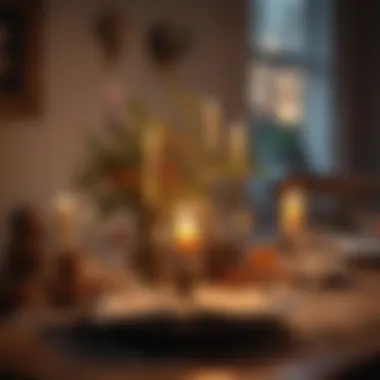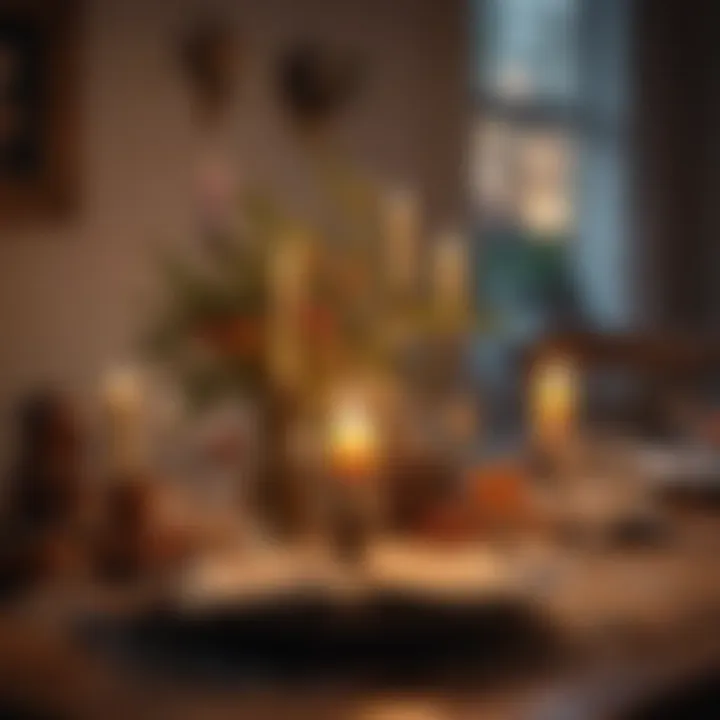Exploring the Essence of the Little Hygge Book


Intro
In a world that often feels frantic and overwhelming, the quest for comfort and warmth becomes ever more vital. The concept of hygge, a Danish word that embodies coziness and contentment, serves as a guiding light for those seeking simpler joys. The Little Hygge Book presents this notion in an accessible manner, offering insights and practical ideas to weave hygge into the fabric of everyday life. By deepening our understanding of hygge, we can cultivate a more intentional and fulfilling existence.
Key Themes Explored
The Little Hygge Book carefully outlines several core themes that define the essence of hygge. These themes not only highlight its cultural significance but also spotlight practical applications that readers can embrace in their daily routines.
Theme Highlights
- Comfort in Simplicity: One of the central tenets of hygge is the joy found in simple pleasures. This might mean enjoying a warm cup of coffee on a rainy day or indulging in a new novel by the fireplace.
- Connection with Others: Hygge emphasizes nurturing relationships. It invites us to share cozy moments with friends and family, be it a leisurely dinner or simply curling up together on the couch.
- Nature’s Embrace: Acknowledging the beauty of the natural world is integral to hygge. The book encourages incorporating elements of nature into our spaces, whether it’s through houseplants or natural light.
- Personal Reflection: Emphasizing the importance of self-care, the book discusses finding time for oneself. It suggests creating rituals that allow one to reflect and unwind from the chaos of daily life.
"Hygge isn't just about the act of being cozy; it's a state of living that celebrates being present in the moment."
Relevant Quotes and Insights
Within the pages of the Little Hygge Book, several quotes stand out, capturing the heart of hygge:
- "To be hygge is to find joy in the ordinary."
- "Cozy corners and warm hearts create a home."
These sentiments challenge the common, fast-paced lifestyle and encourage readers to slow down, take pleasure in the mundane, and create a space full of warmth and love.
Actionable Takeaways
Understanding hygge is one thing; applying it to our lives is where the real magic happens. Here are some practical strategies to help bring hygge into focus.
Practical Tips and Strategies
- Create a Cozy Space: Use soft lighting, comfortable seating, and warm blankets to cultivate a feeling of safety and relaxation in your home.
- Incorporate Rituals: Set aside time each week for activities that nourish your soul, like a simple dinner gathering with loved ones or a solo movie night complete with your favorite snacks.
- Engage with Nature: Make it a point to step outside regularly, whether it's for a morning walk or just to tend to your houseplants.
- Savor Slowing Down: Practice gratitude by keeping a journal. Write down moments from your day that made you feel at peace or content.
Suggested Further Reading
For those inspired to explore the depths of hygge further, consider these resources:
- Encyclopedia Britannica on Hygge
- Wikipedia’s Insight into Danish Culture
- Engage with fellow enthusiasts on platforms like reddit.com or facebook.com to share experiences and tips.
By embracing the philosophy of hygge, we embark on a journey that transforms not only our environment but also our relationships and, ultimately, ourselves.
Prolusion to Hygge
Hygge, a word imbued with warmth and contentment, is much more than just a cultural trend; it's a philosophy that invites us to savor life’s simple joys. In this exploration of the Little Hygge Book, understanding hygge's essence becomes paramount. The topic opens a window into a world where the hustle and bustle of modern life recedes, making way for coziness and connection. It lays the foundation for how to cultivate a deeper sense of well-being and connection to oneself and others.
Defining Hygge
So, what exactly is hygge? Often pronounced like "hoo-gah," it encapsulates a feeling of coziness, comfort, and togetherness. The term has no direct English equivalent, but it implies an atmosphere that encourages relaxation and contentment. Think of it as wrapping oneself in a warm blanket while sipping hot cocoa on a cold winter evening. This essence can be further broken down:
- Cozy spaces: Creating an environment that feels warm and inviting, often with soft lighting and natural materials.
- Mindful moments: Taking the time to appreciate simple pleasures, such as a peaceful evening or a shared meal with loved ones.
- Connectedness: Building relationships and fostering a sense of belonging within one’s community.
Hygge is not merely an aesthetic but a way of life that prompts individuals to prioritize experiences over possessions.
The Origins of Hygge
Delving into the roots of hygge, we find its origins deeply tied to Danish culture. The word itself can be traced back to the 18th century. Many believe it comes from the Norwegian term "hugge," meaning to embrace. From its humble beginnings, hygge emerged as a comforting concept within a geographical and climate context where long, harsh winters could be oppressive. In such an environment, creating warmth and connection became essential.
As the years progressed, hygge evolved alongside Danish society, reflecting the values and lifestyles of the people. It became associated with slower living and an appreciation for life's little pleasures. Achieving hygge does not require grandeur; often, it is found in the smallest of moments: a good book under a blanket or a few friends by candlelight.
Cultural Significance in Danish Society
In Denmark, hygge is woven into the cultural fabric. It’s considered a crucial aspect of the nation’s identity. Danes frequently score high in global happiness rankings, much attributed to their ability to embrace hygge. The cultural significance is manifold:
- Mental Well-Being: Embracing hygge contributes to mental health, as it encourages relaxation and self-care.
- Community Bonding: Hygge strengthens relationships, fostering a sense of camaraderie.
- Quality of Life: It prioritizes comfort and joy over material possessions, promoting a fulfilling lifestyle.
Denmark's penchant for coziness is evident in its long-standing traditions surrounding holidays and family gatherings. For example, the Danish concept of "hyggejul" encapsulates the warmth and intimacy of Christmas celebrations.
"Hygge is not just a vague idea; it's a way to experience life fully, appreciating the small moments as they come."
Understanding hygge within this rich cultural context enhances the reader's perception of what it truly means to live with intention and warmth. As we move forward, appreciating how this principles translates into practical applications in daily life can help reframe our approach to well-being.
The Little Hygge Book: An Overview
In delving into The Little Hygge Book, one can begin to unearth not just the principles of hygge, but also an invitation to redefine what makes life enjoyable and fulfilling. This section highlights the core structure and intent behind the book, prime themes conveyed, and the unique lens through which the author approaches the essence of coziness and comfort.


Structure and Purpose
The structure of The Little Hygge Book is deliberate and thoughtful, guiding readers on a journey through the intricacies of hygge. At its core, the book is organized in a manner that encourages reflection and interaction. Each chapter flows into the next, weaving the theoretical understanding of hygge with practical applications that individuals can incorporate into their daily lives.
The purpose of the book transcends mere description. It's about engaging the reader in discovering their own pathways to warmth and contentment. The ideas presented are not mere theories but serve as gentle nudges for readers to explore feelings of safety and togetherness.
Key Themes and Messages
The key themes in The Little Hygge Book are manifold and rich in depth. Some prominent messages include:
- Mindfulness: An emphasis on being present and appreciating small moments.
- Connection: Highlighting the importance of relationships, both with others and oneself.
- Simplicity: Advocating for the joy found in the uncomplicated aspects of life.
- Nature: Encouraging a harmonious relationship with the natural world, which greatly contributes to creating a hygge environment.
In these pages, readers will find a consistent call to appreciate the mundane, transforming it into something warm and welcoming.
Author's Perspective
The author's unique perspective stands out as a beacon of insight. With a background that seems to dance between personal experience and cultural understanding, they weave the narrative in a way that is relatable yet profound. The voice is neither overly academic nor casual but strikes a balance that resonates with a wide range of readers.
They view hygge not just as a trend but as a vital part of Scandinavian life that can inspire global practices in pursuing joy and comfort. Through stories, personal anecdotes, and reflections, the author crafts a compelling argument for integrating hygge into everyday existence.
"Hygge is more than a word; it is a feeling that can be nurtured in the quiet of your home, in laughter shared with friends, or even in a moment of solitude with a good book."
In sum, this section sets the stage for a broader exploration into how readers can gradually embrace the principles of hygge in their lives, fostering not only contentment but a deeper sense of community and connection.
Applying Hygge in Daily Life
The concept and practice of hygge transcend mere aesthetics and dive into the realm of experience. Integrating hygge into daily life fosters an environment steeped in comfort and warmth, offering a sanctuary from the relentless pace of modern living. Applying hygge is not merely about physical spaces or activities but cultivating a deeper connection with oneself and the world around. This integration enables individuals to pause and relish the moment, fostering well-being and satisfaction.
Creating Cozy Spaces
Creating cozy spaces is the first step in experiencing hygge fully. A cozy environment is one where you feel instantly at home, like wrapping yourself in a soft, warm blanket. It involves taking stock of your surroundings and adding elements that evoke comfort. This could range from plush cushions and soft lighting to cherished photographs or meaningful trinkets.
Consider the role of lighting—soft, warm lights, perhaps from candles or gentle lamps, can transform a room from stark to inviting, signaling to your mind that it's time to unwind.
Some key elements for a cozy space include:
- Textiles: Soft rugs, blankets, and cushions.
- Natural Elements: Plants or flowers to bring a bit of nature indoors.
- Personal Touch: Add items that tell your story or remind you of happy moments.
However, sometimes we can overdo it. It’s easy to clutter spaces with too many accents, thinking that more is better. In this case, learn to choose a few meaningful pieces that contribute to tranquility rather than chaos.
Engaging in Meaningful Activities
Hygge thrives in the realm of meaningful activities that bring happiness and contentment. Engaging with loved ones or enjoying some quiet time can be immensely fulfilling. Here are three distinct ways to manifest this engagement:
Reading and Literature
Reading is a classic hygge activity, embodying the idea of losing oneself in a good book. The significance of reading lies in its ability to transport the reader to different worlds. Whether it’s curling up with a novel or flipping through poetry by a fireplace, the act of reading injects calm into daily chaos.
The key aspect of reading is the opportunity it provides for reflection and mindfulness, a perfect escape from the clamor of social media and daily distractions. Some advantages of incorporating reading into your hygge routine include:
- Mental Stimulation: Keeps the mind sharp and sparks creativity.
- Emotional Connection: Often books resonate with feelings, offering a sense of companionship.
However, make sure to choose the right material. A book that feels like a chore or is too heavy can zap the joy from reading. Opt instead for genres that uplift or hold your interest.
Cooking and Food Experiences
Cooking is another avenue for cultivating hygge, as preparing food can ignite a sense of groundedness and joy. Think of whipping up a hearty stew or baking a loaf of bread; the act is as comforting as the end result. Cooking provides an opportunity to slow down and enjoy what you’re doing rather than rushing through meal prep.
The central characteristic of cooking is its communal aspect. Sharing a meal, whether with family or friends, creates a bond strengthened by the shared experience. Some advantages of cooking include:
- Creativity: Experimenting with flavors can be a delightful outlet.
- Satisfaction: There’s often a deep sense of accomplishment after preparing a meal.
Yet, keep in mind that cooking can sometimes feel overwhelming. Starting with simple recipes can keep the joy intact instead of introducing stress.
Art and Craft Projects
Engaging in art and crafts represents another enjoyable weekend or evening endeavor to weave hygge into your life. Whether painting, knitting, or creating DIY home decor, these activities allow for self-expression and mindfulness.
A fascinating aspect of art and craft projects is that they can be embedded with personal meaning. Handmade items evoke a sense of pride and connection to one’s creativity. Advantages of such activities might include:
- Therapeutic Effect: Many find peace in creating something tangible.
- Connects with Heritage: Craft projects can reflect cultural roots or personal history.


However, as with cooking, the pressure to produce something extraordinary can extinguish the spark intended in these activities. Emphasize the journey over the destination; enjoy the process more than the end product.
The Importance of Community
Building a community is at the heart of hygge's philosophy. The relationships we nurture and the time spent with those we care about contribute immensely to our sense of well-being. Gathering with family and friends encourages warmth and uplift, creating shared memories. It's through these connections that the sense of belonging flourishes.
"Hygge is about creating a warm atmosphere and enjoying the good things in life with good people."
These practices form the bedrock of a hygge lifestyle, inviting joy into our everyday existence.
Hygge and Mental Well-Being
Hygge, a word that can hardly be translated to English, embodies a deep sense of comfort and well-being that goes beyond the surface level. In this ever-changing world, where rapid developments can often lead to feelings of disconnection and anxiety, embracing hygge offers a sanctuary. It’s like creating a cozy nook in the chaotic storm of 21st-century life.
The Psychological Benefits of Hygge
One of the cornerstones of hygge is its mental health advantages. This concept emphasizes contentment, a mental state that some might overlook amidst life's hustle and bustle. Engaging in hygge can be as simple as brewing a warm cup of tea and snuggling up with a book, allowing individuals to create an environment where their minds can unwind. Studies indicate that incorporating these hygge elements into daily routines may reduce symptoms of depression and anxiety.
Moreover, hyge’s focus on being present can enhance mindfulness. Practicing mindfulness enables individuals to appreciate the small moments—feeling the warmth of a candle or enjoying a hearty meal with friends—which leads to increased levels of happiness and satisfaction.
"Taking time to sit back and enjoy the present is as essential to mental health as eating well and exercising."
Reducing Stress Through Hygge Practices
In today's fast-paced life, stress can feel like a relentless wave, sweeping people off their feet. Integrating hygge into one’s life can help counteract this tide. When people immerse themselves in maximizing coziness—whether it’s by lighting scented candles, preparing comfort food, or crafting a peaceful space to unwind—they create their own stress-free zone. The key here is intentionality.
Consciously seeking comfort helps in switching the mind from a state of stress to one of relaxation. Research highlights that such environments foster a shift in mood, reducing levels of cortisol, the stress hormone.
- Lighting softens the mood.
- Textures of soft blankets invite touch.
- Sounds of soft music can calm the mind.
This trifecta of sensory engagement opens the door to a more tranquil mental space, making it easier to deal with challenges.
Fostering Relationships
Connection forms the very fabric of hygge’s appeal. At its heart, hygge is about shared experiences and fostering relationships. Gathering around a dinner table, telling stories, and savoring laughter with loved ones are staples of this cozy lifestyle. These moments are vital for emotional health.
When individuals invest time in nurturing relationships—whether with family, friends, or even community members—they cultivate bonds that enhance feelings of belonging and security. As the Danish proverb goes, "Shared joy is a double joy; shared sorrow is half a sorrow."
Incorporating hygge into social settings can be as simple as a themed evening—a game night with comforting snacks or a movie marathon with soft cushions. These scenarios not only promote connection but also offer an invaluable opportunity to unwind together, fortifying emotional ties that last well beyond a single evening.
By weaving hygge into mental health practices, individuals cultivate a richer tapestry of well-being that promotes joy, connection, and a profound sense of peace.
Hygge Beyond Scandinavia
The concept of hygge is often labeled as a Scandinavian treasure, but its influence reaches far beyond the chilly Nordic borders. As societies globally look for comfort amid chaos, hygge offers a warm embrace that transcends cultural boundaries. It's not merely a trend in cozy marketing; it’s become a lifestyle that many around the world seek out to nurture a sense of belonging and peace. Understanding how hygge has been adapted elsewhere can provide insights not only into the practices themselves but also into the shared human desire for warmth and connection.
Global Adoption of Hygge Principles
When we talk about the global adoption of hygge, it’s like watching a plant take root in different soils, adjusting its form to thrive. Countries ranging from the United States to Japan have embraced the hygge philosophy, discovering their unique twists on this concept. Here are a few examples:
- In America, hygge-inspired cafes pop up with warm lighting and a carefully curated selection of artisanal coffees and pastries, aimed at fostering community and relaxation. The focus on atmosphere and connection echoes the essence of hygge.
- In Japan, the practice of wabi-sabi, which finds beauty in imperfection, dovetails beautifully with hygge. The simplicity and appreciation of life’s transience solidly align with those cozy Danish vibes.
- Australian communities bring hygge into the outdoors, finding comfort in barbecues under the stars and gathering around fire pits, making communal connections through the warmth of shared experiences.
This cross-pollination of ideas illustrates that hygge principles can thrive in diverse environments, adapting to local customs while resonating with universal human inclinations toward comfort and bonding.
Hygge in Different Cultures
The beauty of hygge lies in its flexibility; it is not shackled to one interpretation. Across various cultures, hygge has reshaped itself, inviting new expressions of coziness and togetherness. In examining how different nations adopt hygge, we can appreciate the fusion of various traditions, which enriches the concept itself.
- In France, joie de vivre becomes the lens through which hygge is experienced. Their long dinners surrounded by friends translate into the Danish relaxation style, focusing on savoring food and connection—much like a hygge dinner.
- In India, practices such as chai time bring people together, fostering a sense of community and comfort. Here, the sharing of tea is more than warmth from a drink—it's about nurturing relationships, central to the hygge philosophy.
- In Italy, enjoying an evening gathering over delicious pasta and sunlight-drenched outdoor spaces showcases their own version of hygge, where people connect and celebrate the joys of life.
Cultural Appropriation vs. Appreciation
As the hygge movement spreads, it's crucial to navigate the thin line between cultural appropriation and appreciation. Engaging with hygge in various contexts requires sensitivity and understanding. It is essential to recognize the origins of the concepts while integrating them respectfully into different cultures.
Cultural appreciation means valuing the essence of hygge without stripping it of its roots or reducing it to mere aesthetic choices. It is like borrowing a sweater from a friend—appreciating it while understanding where it came from, and always returning it with respect.
To foster appreciation rather than appropriation, consider these points:
- Educate Yourself: Before adopting elements of hygge, it’s prudent to educate oneself about its origins and meaning.
- Engage with Authenticity: Seek genuine connections with the culture from which hygge originates. Participate in experiences rather than merely decorating a space post-haste.
- Value Diversity: Recognize that hygge can take on many forms, reflecting the diverse expressions of its principles across cultures.
This exploration of hygge beyond Scandinavia invites a deeper understanding of how this concept integrates within various cultural frameworks. In a world that craves connection, hygge serves as a beacon, inspiring individuals to cherish their homes, friendships, and moments of joy, irrespective of where they live.


Critiques of the Hygge Concept
Hygge, a concept so revered in Danish culture, has started to attract a fair amount of scrutiny as it gains traction around the world. Understanding these critiques is critical for a comprehensive take on hygge. It underscores not only the challenges of intercultural exchange but also the pitfalls of commodifying an intricate concept that previously held deep cultural significance. Examining these critiques helps to refine our appreciation for hygge, ensuring it retains its essence while adapting to modern expectations.
The Commercialization of Hygge
As hygge has become a buzzword, the risk of commercialization looms large. Cozy blankets, scented candles, and artisanal coffee shops—these products claim to embody the spirit of hygge, yet they often miss the deeper meanings it actually conveys. While comfort is an essential aspect, the core of hygge lies in fostering connection and tranquility.
The merchandising frenzy raises questions about authenticity. When brands try to sell the essence of hygge, do they really encapsulate its true nature? For instance, a cafe may market itself as a "hygge haven" with plush seating and dim lighting, but if the environment is stilted and corporate, one might leave feeling more isolated than cozy.
In essence, commercialization can reduce hygge to merely a marketing ploy rather than a true lifestyle philosophy—leading many to view it with skepticism.
Misinterpretations of Hygge
Misunderstanding can muddy the waters for those trying to adopt hygge in their own lives. The central belief that hygge is all about comfort can simplify its richness. People may think having a cozy corner at home filled with plush cushions equates to living hygge. However, hygge is so much more than physical comfort. It's about emotional satisfaction and creating warmth in relationships. In fact, hygge can even thrive in simpler settings, where the focus shifts from material goods to shared experiences.
For example, the act of gathering for a meal with loved ones can embody hygge, even if the ingredients are simple or the setting is modest. Misinterpretations like this can lead individuals to feel inadequate if they don’t have the latest hygge-inspired items—when the true spirit of hygge is about genuine enjoyment and connection.
"Hygge is not about perfection, but about creating moments that resonate with joy and togetherness."
Potential Limitations
While hygge promotes tranquility and coziness, it is not without its limitations. Critics argue that the idealization of abundance in comfort can create unrealistic expectations. In environments where stress is a constant companion, seeking out hygge can become an elusive goal. Not everyone has the privilege to create atmospheres imbued with warmth, nor do they have the time to invest in these cozy rituals.
Additionally, the notion of hygge might inadvertently encourage escapism rather than coping with difficulties. Seeking warmth and comfort during hard times is natural, yet the emphasis on maintaining comfort can lead to avoidance rather than problem-solving. Life encompasses a spectrum of experiences, and sometimes confronting the harsh realities brings about personal growth more than wrapping oneself in a blanket ever could.
In summary, reflecting on the critiques of hygge provides a broader context through which one can appreciate its essence while navigating the inherent challenges and misconceptions. Understanding these nuances enriches our engagement with the concept and empowers us to truly integrate hygge in a meaningful way.
Future of Hygge in Contemporary Society
As we navigate through an era marked by fast-paced changes and digital communication, hygge finds itself evolving yet again. This concept is not just a nostalgic nod to simpler times; it’s a necessary framework for well-being that resonates deeply in contemporary life. The importance of hygge in this society lies in its ability to bridge gaps between individuals and create serene spaces amidst chaos. It offers a path to connection, grounding, and calmness. With daily distractions becoming the norm, understanding how hygge adapts can provide beneficial insights to our overall lifestyle choices.
Evolving Definitions
Hygge has shifted from a quaint Danish tradition to a global phenomenon, with definitions expanding beyond the cozy aesthetics typically associated with it. Traditionally, hygge was about warmth and comfort—think soft blankets, candlelit evenings, and the companionship of loved ones. Today, it is transforming into a broader notion that encompasses mental wellness, self-care, and intentional living.
The modern interpretation includes practices such as mindfulness, quilting the coziness into one's daily routine rather than just focusing on physical surroundings. People often associate it with being present—enjoying a hot cup of tea while the world whirls outside. This evolution highlights how we can adapt timeless concepts to suit our life's changing demands.
The Role of Technology
In a world dominated by technology, hygge does not simply resist the influence of screens and social media; it finds ways to coexist. One could argue that finding balance in our relationship with technology is the essence of modern hygge.
- Digital detoxes can create space for cozy moments.
- Mindful scrolling, where one engages positively with content, can amplify feelings of connection and warmth.
Moreover, technology can aid in the pursuit of hygge through practices like virtual gatherings. With apps that let friends share cozy moments from afar or participate in cooking classes online, the spirit of togetherness remains intact even when physically apart. Still, it’s crucial to discern when technology contributes to our hygge moments and when it detracts from them.
Hygge in Work Environments
As the workplace continues to evolve, so too does the application of hygge principles. The conventional office layout can often feel cold and uninspiring. However, applying hygge in work environments can significantly enhance productivity and job satisfaction.
To adopt hygge at work, managers and employees might consider:
- Creating comfortable breakout areas with plants and soft seating.
- Encouraging flexible work hours, allowing individuals to structure their days in a way that maximizes comfort and efficiency.
- Implementing team-building activities that focus on meaningful interactions rather than just purely task-oriented meetings.
The key remains in recognizing that a culture of coziness and comfort at work fosters not only well-being but also creativity and collaboration among team members.
Ultimately, the future of hygge transcends borders and boundaries, reflecting a deep human desire for connection and serenity amidst life’s upheavals.
Finale: The Enduring Appeal of Hygge
Hygge, a concept deeply rooted in Danish culture, has emerged as an invitation to embrace coziness and cultivate a sense of well-being in our everyday lives. The enduring appeal of hygge stems from its simple yet profound philosophy, which encourages individuals to foster connections and find joy in life's little moments. In this increasingly chaotic world, hygge presents not just a trend, but a remedy that resonates with many seeking solace in their environments.
Recapitulating Key Insights
Throughout the exploration of the Little Hygge Book, several key insights emerge. Not only does hygge advocate for creating a cozy atmosphere, but it also emphasizes connection—both with oneself and others. This quiet revolution of mindfulness urges people to step back from the hustle and bustle, advocating for small rituals that bring peace, whether through a warm cup of coffee or heartfelt conversations with friends. Moreover, it showcases how the appreciation of simplicity and the prioritization of experiences lead to deeper contentment.
Embracing hygge means choosing quality over quantity and nurturing relationships that enrich our lives. These principles are universal, transcending cultural boundaries and igniting a desire in many to integrate these peaceful practices into their daily routines.
Personal Reflection on Hygge Practices
Reflecting on my engagement with hygge practices, I've noticed a shift not only in my surroundings but in my outlook. Adopting a hygge mentality means regularly carving out time to cherish mundane moments and creating spaces that encourage serenity—like draping a soft blanket over the sofa or lighting a simple candle during dinner. This emphasis on careful attention to everyday life has helped me appreciate the richness that simplicity brings.
Personal stories about gathering with friends during a winter evening, seated with warm drinks and sharing stories, serve as reminders that human connections thrive in these cozy settings. It's within these intimate gatherings, filled with laughter and warmth, that the true spirit of hygge comes alive.
Call to Action for Readers
For those inspired by the insights offered in this article, I urge you to embark on your own hygge journey. Start small; perhaps light a candle during dinner or create a cozy reading nook in your home. Consider hosting a simple gathering with friends and let the conversations flow naturally over a cup of tea.
"Hygge is not something that can be bought; it's a state of being that invites appreciation for the here and now."
Connect with others, let go of the pressures that inform your existence, and cultivate a practice that allows for introspection and joy. As you adopt these principles into your life, you might just discover that the path to contentment lies in navigating the ordinary with mindfulness and gratitude.















